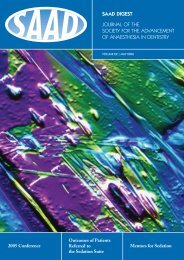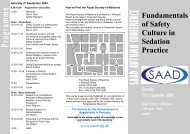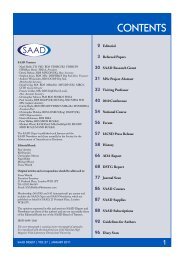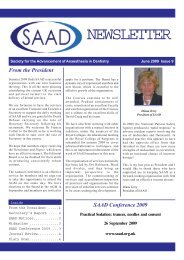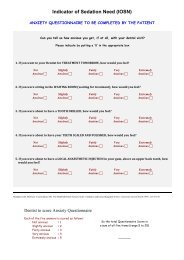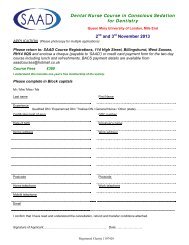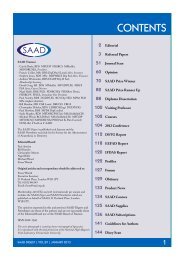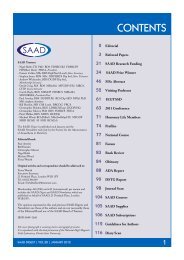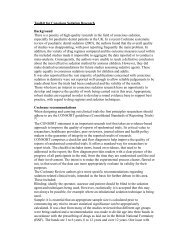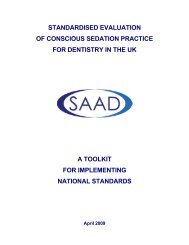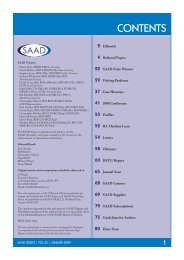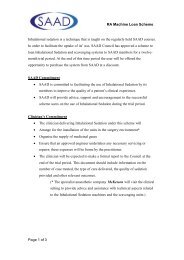Standards for Conscious Sedation in Dentistry: Alternative Techniques
Standards for Conscious Sedation in Dentistry: Alternative Techniques
Standards for Conscious Sedation in Dentistry: Alternative Techniques
You also want an ePaper? Increase the reach of your titles
YUMPU automatically turns print PDFs into web optimized ePapers that Google loves.
<strong>Standards</strong> <strong>for</strong> <strong>Conscious</strong> <strong>Sedation</strong> <strong>in</strong> <strong>Dentistry</strong>:<br />
<strong>Alternative</strong> <strong>Techniques</strong><br />
A Report from the Stand<strong>in</strong>g Committee on <strong>Sedation</strong> <strong>for</strong> <strong>Dentistry</strong><br />
2007
The Royal College of Anaesthetists<br />
The UK Academy of Medical Royal Colleges and their Faculties <strong>in</strong> 2001<br />
commissioned the Royal College of Anaesthetists to establish an<br />
Intercollegiate Work<strong>in</strong>g Party to review evidence on the safe provision of<br />
sedation services and produce recommendations applicable to the full range<br />
of tra<strong>in</strong><strong>in</strong>g and practice. The report of the Work<strong>in</strong>g Party acknowledged that<br />
the dental profession had been more effective <strong>in</strong> produc<strong>in</strong>g and follow<strong>in</strong>g<br />
appropriate guidel<strong>in</strong>es <strong>in</strong><br />
Educat<strong>in</strong>g,<br />
sedation<br />
Tra<strong>in</strong><strong>in</strong>g<br />
techniques<br />
and<br />
than<br />
Sett<strong>in</strong>g<br />
had<br />
<strong>Standards</strong><br />
other<br />
<strong>in</strong><br />
discipl<strong>in</strong>es<br />
Anaesthesia,<br />
of<br />
medic<strong>in</strong>e and Critical Care and Pa<strong>in</strong> Management<br />
surgery <strong>in</strong> general. Nevertheless the open<strong>in</strong>g passage<br />
<strong>Sedation</strong> techniques may make unpleasant healthcare procedures more<br />
acceptable to patients but have the potential to cause life-threaten<strong>in</strong>g<br />
complications applied to everyone.<br />
The Board of the Faculty of Dental Surgery and the Council of the Royal<br />
College of Anaesthetists together with our colleagues <strong>in</strong> the Faculty of<br />
General Dental Practice (UK) endorsed earlier guidance provided <strong>in</strong><br />
<strong>Conscious</strong> <strong>Sedation</strong> <strong>in</strong> the Provision of Dental Care published by the<br />
Stand<strong>in</strong>g Dental Advisory Committee <strong>in</strong> 2003. We now commend to you this<br />
new additional guidance encompass<strong>in</strong>g the use of alternative conscious<br />
sedation techniques. Together they have been designed to enable<br />
practitioners to take appropriate steps <strong>in</strong> the provision of a m<strong>in</strong>imum<br />
standard <strong>for</strong> safe and effective patient care whatever the cl<strong>in</strong>ical sett<strong>in</strong>g.<br />
Safety must be paramount and we would like to re-emphasise the<br />
importance of adher<strong>in</strong>g to the def<strong>in</strong>ition of conscious sedation as a<br />
technique <strong>in</strong> which the use of a drug or drugs produces a state of depression<br />
of the central nervous system enabl<strong>in</strong>g treatment to be carried out, but<br />
dur<strong>in</strong>g which verbal contact with the patient is ma<strong>in</strong>ta<strong>in</strong>ed throughout the<br />
period of sedation. The drugs and techniques used to provide conscious<br />
sedation <strong>for</strong> dental treatment should carry a marg<strong>in</strong> of safety wide enough to<br />
render loss of consciousness unlikely.<br />
Professor Brian Avery<br />
Dean<br />
Faculty of Dental Surgery<br />
The Royal College of Surgeons of England<br />
Dr Judith Hulf<br />
President<br />
The Royal College of Anaesthetists<br />
August 2007<br />
3
FACULTY OF DENTAL SURGERY<br />
The Royal College of Surgeons of England<br />
THE ROYAL COLLEGE OF ANAESTHETISTS<br />
<strong>Standards</strong> <strong>for</strong> <strong>Conscious</strong> <strong>Sedation</strong> <strong>in</strong> <strong>Dentistry</strong>:<br />
<strong>Alternative</strong> <strong>Techniques</strong><br />
A Report from the Stand<strong>in</strong>g Committee on <strong>Sedation</strong> <strong>for</strong> <strong>Dentistry</strong>*<br />
CONTENTS<br />
1. Executive Summary Page 5<br />
2. <strong>Standards</strong> <strong>for</strong> <strong>Conscious</strong> <strong>Sedation</strong> <strong>in</strong> <strong>Dentistry</strong>:<br />
<strong>Alternative</strong> <strong>Techniques</strong> Page 7<br />
Guidance Page 8<br />
3. Annex 1 Summary of Second Report of an Expert Work<strong>in</strong>g Group of<br />
the Stand<strong>in</strong>g Dental Advisory Committee (SDAC). September 2005<br />
Page 14<br />
4. Annex 2 Person specification <strong>for</strong> practice assessor<br />
Page 18<br />
5. Annex 3 Inspection checklist Page 19<br />
6. Annex 4 Oral and transmucosal sedation<br />
with midazolam Page 28<br />
7. Annex 5 Members of Committee Page 29<br />
7. Annex 6 Reference documents Page 30<br />
* The Stand<strong>in</strong>g Committee on <strong>Sedation</strong> <strong>for</strong> <strong>Dentistry</strong> was <strong>in</strong>itially established by the Faculty of Dental<br />
Surgery of the Royal College of Surgeons of England, The Royal College of Anaesthetists and the Faculty<br />
of General Dental Practice (UK) <strong>in</strong> 1998 as the successor body to the Tripartite Committee on General<br />
Anaesthesia <strong>for</strong> <strong>Dentistry</strong> which was set up <strong>in</strong> 1992.<br />
4
FACULTY OF DENTAL SURGERY<br />
The Royal College of Surgeons of England<br />
THE ROYAL COLLEGE OF ANAESTHETISTS<br />
<strong>Standards</strong> <strong>for</strong> <strong>Conscious</strong> <strong>Sedation</strong> <strong>in</strong> <strong>Dentistry</strong>:<br />
<strong>Alternative</strong> <strong>Techniques</strong><br />
A Report from the Stand<strong>in</strong>g Committee on <strong>Sedation</strong> <strong>for</strong> <strong>Dentistry</strong><br />
EXECUTIVE SUMMARY<br />
• <strong>Conscious</strong> sedation is def<strong>in</strong>ed as A technique <strong>in</strong> which the use of a drug or drugs produces a state of<br />
depression of the central nervous system enabl<strong>in</strong>g treatment to be carried out, but dur<strong>in</strong>g which<br />
verbal contact with the patient is ma<strong>in</strong>ta<strong>in</strong>ed throughout the period of sedation. The drugs and<br />
techniques used to provide conscious sedation <strong>for</strong> dental treatment should carry a marg<strong>in</strong> of safety<br />
wide enough to render loss of consciousness unlikely<br />
• There rema<strong>in</strong>s disquiet about safety and quality standards <strong>in</strong> the provision of conscious sedation <strong>for</strong><br />
dental care. This applies particularly to the use of more advanced techniques + extend<strong>in</strong>g beyond the<br />
standard techniques* described <strong>in</strong> <strong>Conscious</strong> <strong>Sedation</strong> <strong>in</strong> the Provision of Dental Care [Stand<strong>in</strong>g<br />
Dental Advisory Committee] 2003 1 . There are nevertheless examples of good practice <strong>in</strong> the safe<br />
and effective adm<strong>in</strong>istration of alternative techniques by well tra<strong>in</strong>ed and experienced teams work<strong>in</strong>g<br />
<strong>in</strong> tightly controlled cl<strong>in</strong>ical sett<strong>in</strong>gs.<br />
• This document develops the earlier guidance 1 to encompass the use of alternative conscious<br />
sedation techniques. It has been prepared <strong>for</strong> dental and medical practitioners <strong>in</strong>clud<strong>in</strong>g<br />
anaesthetists and their teams. The comb<strong>in</strong>ed guidance is designed to provide practitioners with the<br />
<strong>in</strong><strong>for</strong>mation they need to ensure they provide conscious sedation services to the specified standards<br />
<strong>in</strong> order to safeguard patients regardless of the cl<strong>in</strong>ical sett<strong>in</strong>g. The standards set out <strong>in</strong> this guidel<strong>in</strong>e<br />
are the m<strong>in</strong>imum requirements.<br />
• The guidance on standards <strong>for</strong> alternative sedation techniques requires that <strong>for</strong> safe practice:<br />
○ Premises must comply with the standards required <strong>for</strong> the practice of dentistry but the wait<strong>in</strong>g<br />
area, surgery and recovery facilities require additional consideration (Paragraph 1)<br />
○ Drugs & equipment should be appropriate <strong>for</strong> the techniques utilised and <strong>in</strong>clude those<br />
required <strong>for</strong> sedation, monitor<strong>in</strong>g, the management of complications and resuscitation<br />
○ The Team <strong>in</strong>cludes operator/sedationist, dedicated sedationist, dental care professionals<br />
(DCPs), recovery personnel and support staff<br />
○ Patients’ medical and dental histories, age, ASA, psychological status, weight, social aspects<br />
and the proposed dental procedures must be carefully considered<br />
○ Documentation and protocols must comply with contemporary cl<strong>in</strong>ical governance<br />
standards but additional consideration must be given to assessment and preparation, written<br />
valid consent, the technical procedure and recovery, written <strong>in</strong>structions <strong>for</strong> patient and escort<br />
○ Qualifications & Tra<strong>in</strong><strong>in</strong>g Requirements <strong>for</strong> the practitioner adm<strong>in</strong>ister<strong>in</strong>g sedation us<strong>in</strong>g<br />
alternative techniques should acknowledge differences <strong>in</strong> educational and tra<strong>in</strong><strong>in</strong>g back<br />
grounds (Paragraph 2). <strong>Conscious</strong> sedation <strong>for</strong> children must be provided only by those who<br />
are tra<strong>in</strong>ed and experienced <strong>in</strong> sedat<strong>in</strong>g children and where appropriate equipment and<br />
facilities are available 1 10<br />
○ Entry to tra<strong>in</strong><strong>in</strong>g <strong>in</strong> specific alternative techniques + requires that practitioners must have<br />
documented experience of the relevant <strong>in</strong>travenous or <strong>in</strong>halational standard techniques (at<br />
least 100 cases over the last 2 years) and not less than 4 years post-registration experience <strong>in</strong><br />
the United K<strong>in</strong>gdom as a dental or medical practitioner (Paragraph 3)<br />
5
~ Standard <strong>Techniques</strong> are def<strong>in</strong>ed as<br />
-Intravenous sedation us<strong>in</strong>g midazolam alone<br />
-Inhalational sedation us<strong>in</strong>g nitrous oxide / oxygen<br />
-oral / transmucosal benzodiazep<strong>in</strong>e* provided adequate competence <strong>in</strong> <strong>in</strong>travenous techniques has been demonstrated<br />
*The transmucosal adm<strong>in</strong>istration of conscious sedation is regarded by some sedationist as fall<strong>in</strong>g with<strong>in</strong> the category of standard<br />
techniques. Nevertheless it is essential that strict protocols are <strong>in</strong> place SEE ANNEX 4<br />
+ <strong>Alternative</strong> techniques <strong>in</strong>clude<br />
-any <strong>for</strong>m of conscious sedation <strong>for</strong> patients under the age of 12 years # other than nitrous oxide/oxygen <strong>in</strong>halation sedation<br />
-benzodiazep<strong>in</strong>e + any other <strong>in</strong>travenous agent <strong>for</strong> example: opioid, propofol, ketam<strong>in</strong>e<br />
-propofol either alone or with any other agent <strong>for</strong> example: benzodiazep<strong>in</strong>e, opioid, ketam<strong>in</strong>e<br />
-<strong>in</strong>halational sedation us<strong>in</strong>g any agent other than nitrous oxide / oxygen alone<br />
-comb<strong>in</strong>ed (non-sequential) routes <strong>for</strong> example: <strong>in</strong>travenous + <strong>in</strong>halational agent (except <strong>for</strong> the use of nitrous oxide /<br />
oxygen dur<strong>in</strong>g cannulation)<br />
#<br />
It is recognised that the physical and mental development of <strong>in</strong>dividuals varies and may not necessarily correlate with the<br />
chronological age<br />
6
FACULTY OF DENTAL SURGERY<br />
The Royal College of Surgeons of England<br />
THE ROYAL COLLEGE OF ANAESTHETISTS<br />
<strong>Standards</strong> <strong>for</strong> <strong>Conscious</strong> <strong>Sedation</strong> <strong>in</strong> <strong>Dentistry</strong>:<br />
<strong>Alternative</strong> <strong>Techniques</strong><br />
A Report from the Stand<strong>in</strong>g Committee on <strong>Sedation</strong> <strong>for</strong> <strong>Dentistry</strong><br />
This document has been prepared <strong>for</strong> the guidance of dental and medical practitioners<br />
<strong>in</strong>clud<strong>in</strong>g anaesthetists and their teams who provide conscious sedation services to<br />
supplement local anaesthesia <strong>for</strong> the provision of dental care. It develops the guidance<br />
provided <strong>in</strong> <strong>Conscious</strong> <strong>Sedation</strong> <strong>in</strong> the Provision of Dental Care (which covered the<br />
standard techniques) published by the Stand<strong>in</strong>g Dental Advisory Committee <strong>in</strong> 2003 1 to<br />
encompass the use of alternative conscious sedation techniques [as def<strong>in</strong>ed on page 5].<br />
This comb<strong>in</strong>ed guidance should enable practitioners to take appropriate steps <strong>in</strong> the<br />
provision of a m<strong>in</strong>imum standard <strong>for</strong> safe and effective patient care whatever the cl<strong>in</strong>ical<br />
sett<strong>in</strong>g. The importance of adher<strong>in</strong>g to the def<strong>in</strong>ition of conscious sedation is<br />
re-emphasised as a technique <strong>in</strong> which the use of a drug or drugs produces a state of<br />
depression of the central nervous system enabl<strong>in</strong>g treatment to be carried out, but dur<strong>in</strong>g<br />
which verbal contact with the patient is ma<strong>in</strong>ta<strong>in</strong>ed throughout the period of sedation.<br />
The drugs and techniques used to provide conscious sedation <strong>for</strong> dental treatment<br />
should carry a marg<strong>in</strong> of safety wide enough to render loss of consciousness unlikely<br />
It is important to recognise that conscious sedation <strong>for</strong> children must be provided only by<br />
those who are tra<strong>in</strong>ed and experienced <strong>in</strong> sedat<strong>in</strong>g children and where appropriate<br />
equipment and facilities are available 1 10<br />
Implementation will require careful consideration by a range of professional, provider and<br />
commission<strong>in</strong>g organisations.<br />
BACKGROUND:<br />
In 2004, The Chief Dental Officer (CDO) <strong>for</strong> England <strong>in</strong>vited the Stand<strong>in</strong>g Dental Advisory<br />
Committee (SDAC) to take <strong>for</strong>ward work <strong>in</strong> develop<strong>in</strong>g a strategy and make<br />
recommendations on:<br />
• More rigorous ma<strong>in</strong>tenance of safety and quality standards <strong>for</strong> conscious sedation<br />
<strong>in</strong> the provision of dental care<br />
• Improv<strong>in</strong>g access to more effective services <strong>for</strong> pa<strong>in</strong> and anxiety control by<br />
deliver<strong>in</strong>g appropriate techniques matched to <strong>in</strong>dividual patient needs <strong>in</strong> a timely<br />
manner at a convenient location<br />
Subsequently the Royal colleges <strong>in</strong> liaison with specialist associations developed this<br />
guidance <strong>in</strong> the light of their responsibility <strong>for</strong> the sett<strong>in</strong>g and monitor<strong>in</strong>g of quality and<br />
safety standards <strong>in</strong> the application of safe sedation techniques.<br />
7
THE NEED FOR THIS GUIDANCE<br />
There rema<strong>in</strong>s disquiet about safety and quality standards <strong>in</strong> the provision of conscious<br />
sedation <strong>for</strong> dental care. This applies particularly to the use of more advanced techniques<br />
extend<strong>in</strong>g beyond those described <strong>in</strong> <strong>Conscious</strong> <strong>Sedation</strong> <strong>in</strong> the Provision of Dental<br />
Care 1 . There are nevertheless examples of good practice <strong>in</strong> the safe and effective<br />
adm<strong>in</strong>istration of alternative techniques, a number with<strong>in</strong> randomised controlled trials 12-17<br />
show<strong>in</strong>g that they can be used by well tra<strong>in</strong>ed and experienced teams (often <strong>in</strong>volv<strong>in</strong>g<br />
anaesthetists as well as dentists) to provide conscious sedation (accord<strong>in</strong>g to the def<strong>in</strong>ition of page 3)<br />
work<strong>in</strong>g <strong>in</strong> tightly controlled cl<strong>in</strong>ical sett<strong>in</strong>gs. In addition patients cont<strong>in</strong>ue to report<br />
difficulty <strong>in</strong> ga<strong>in</strong><strong>in</strong>g access to services <strong>for</strong> the assessment and appropriate control of pa<strong>in</strong><br />
and anxiety <strong>in</strong> dentistry <strong>in</strong>clud<strong>in</strong>g both conscious sedation and general anaesthesia.<br />
In response to the <strong>in</strong>vitation of the then CDO <strong>for</strong> England to take <strong>for</strong>ward further strategic<br />
work <strong>in</strong> this field the SDAC once aga<strong>in</strong> convened an Expert Work<strong>in</strong>g Group. The<br />
conclusions and recommendations reached <strong>in</strong> its report of September 2005 are set out <strong>in</strong><br />
Annex 1. These highlighted:<br />
■ the pr<strong>in</strong>ciples set out <strong>in</strong> <strong>Conscious</strong> <strong>Sedation</strong> <strong>for</strong> the Provision of Dental Care 1<br />
provide guidance applicable to all sectors of dentistry; lay<strong>in</strong>g emphasis on the<br />
tra<strong>in</strong><strong>in</strong>g <strong>for</strong> and adm<strong>in</strong>istration of the standard techniques which ensure a wide<br />
marg<strong>in</strong> of safety.<br />
■ an urgent need <strong>for</strong> more rigorous monitor<strong>in</strong>g of quality and safety standards at the<br />
local level.<br />
■ that a robust system <strong>for</strong> assessment of the quality and safety standards of all NHS<br />
and <strong>in</strong>dependent cl<strong>in</strong>ical teams should be <strong>in</strong>troduced and matched to the type of<br />
service provided<br />
■ a proposal that referral centres provid<strong>in</strong>g an extended range of techniques clearly<br />
based on local needs be <strong>in</strong>troduced<br />
■ a need to develop and cont<strong>in</strong>uously update guidance on the quality standards<br />
required of such centres<br />
■ the <strong>in</strong>troduction of such centres would present opportunities to l<strong>in</strong>k teach<strong>in</strong>g, tra<strong>in</strong><strong>in</strong>g<br />
and research to service provision<br />
Follow<strong>in</strong>g preparation of these recommendations there was a significant change <strong>in</strong> the<br />
national commission<strong>in</strong>g patterns and provision of dental services. More recently the<br />
Department of Health has published updated guidance on the commission<strong>in</strong>g of<br />
conscious sedation services <strong>in</strong> primary dental care 11 . Under these circumstances and <strong>in</strong><br />
view of the need <strong>for</strong> supplementary guidance on standards this work was then taken<br />
<strong>for</strong>ward by the Royal Colleges who produced the follow<strong>in</strong>g recommendations.<br />
8
GUIDANCE ON STANDARDS<br />
REQUIREMENTS FOR SAFE PRACTICE<br />
Requirements <strong>for</strong> the adm<strong>in</strong>istration of standard and alternative techniques have been<br />
considered under the three broad head<strong>in</strong>gs of:<br />
■ Environment and patient selection<br />
■ Qualifications and tra<strong>in</strong><strong>in</strong>g<br />
■ Experience and cont<strong>in</strong>u<strong>in</strong>g professional development<br />
For quality assurance <strong>in</strong> the delivery of safe patient care it is essential that these factors<br />
converge as emphasised by Figures 1 and 2 below. The area of convergence of the three<br />
circles represents the m<strong>in</strong>imum acceptable standards <strong>for</strong> the practice of conscious<br />
sedation utilis<strong>in</strong>g a range of techniques alternative to the recognised standard techniques<br />
Standard techniques are:<br />
ο Inhalational sedation us<strong>in</strong>g nitrous oxide / oxygen<br />
ο Intravenous sedation us<strong>in</strong>g midazolam alone<br />
○ Oral / transmucosal benzodiazep<strong>in</strong>e* provided adequate competence <strong>in</strong> <strong>in</strong>travenous<br />
techniques has been demonstrated.<br />
*The transmucosal adm<strong>in</strong>istration of conscious sedation is regarded by some sedationist as fall<strong>in</strong>g with<strong>in</strong> the<br />
category of standard techniques. Nevertheless it is essential that strict protocols are <strong>in</strong> place SEE ANNEX 4<br />
<strong>Alternative</strong> techniques <strong>in</strong>clude<br />
ο any <strong>for</strong>m of conscious sedation <strong>for</strong> patients under the age of 12 years # other than<br />
nitrous oxide/oxygen <strong>in</strong>halation sedation<br />
ο benzodiazep<strong>in</strong>e + any other <strong>in</strong>travenous agent with sedative effects <strong>for</strong> example:<br />
opioid, propofol, ketam<strong>in</strong>e<br />
ο propofol either alone or with any other agent <strong>for</strong> example: benzodiazep<strong>in</strong>e, opioid,<br />
ketam<strong>in</strong>e<br />
ο <strong>in</strong>halational sedation us<strong>in</strong>g any agent other than nitrous oxide / oxygen alone<br />
ο comb<strong>in</strong>ed (non-sequential) routes <strong>for</strong> example: <strong>in</strong>travenous + <strong>in</strong>halational agent<br />
(except <strong>for</strong> the use of nitrous oxide / oxygen dur<strong>in</strong>g cannulation)<br />
# It is recognised that the physical and mental development of <strong>in</strong>dividuals varies and may not<br />
necessarily correlate with the chronological age<br />
9
Fig 1 Components <strong>for</strong> the delivery of safe patient care<br />
These together with cont<strong>in</strong>u<strong>in</strong>g professional development and cl<strong>in</strong>ical audit represent a<br />
dynamic framework underp<strong>in</strong>n<strong>in</strong>g safe practice. The relative proportions of each<br />
component are not fixed: qualifications and tra<strong>in</strong><strong>in</strong>g should be the foundation of safe<br />
practice whilst the selection of patients and the environment are dependent upon the<br />
experience of the sedationist. Cont<strong>in</strong>u<strong>in</strong>g professional development is vital <strong>in</strong> ma<strong>in</strong>ta<strong>in</strong><strong>in</strong>g<br />
a l<strong>in</strong>k with current standards and guidel<strong>in</strong>es.<br />
Safe Practice<br />
Environment and<br />
Patient Selection<br />
Experience<br />
Qualifications and Tra<strong>in</strong><strong>in</strong>g<br />
Fig 2 Quality assurance <strong>for</strong> safe practice <strong>in</strong> patient care<br />
10
The aim is to ensure that effective treatment given to patients is provided safely and that<br />
it is well with<strong>in</strong> the competencies of the dentist / sedationist, dedicated sedationist and<br />
whole practice care team.<br />
Each of the paragraphs 1-3 below should be cross-referenced with the Inspection<br />
Checklist <strong>for</strong> the Provision of <strong>Alternative</strong> <strong>Conscious</strong> <strong>Sedation</strong> Services <strong>in</strong> Annex 3.<br />
[It is important to recognise that there is a clear dist<strong>in</strong>ction between this list and the one published<br />
<strong>in</strong> Commission<strong>in</strong>g <strong>Conscious</strong> <strong>Sedation</strong> Services <strong>in</strong> Primary Dental Care 11 which refers to the<br />
standard techniques]<br />
1. ENVIRONMENT REQUIREMENTS<br />
1.1 The Physical facilities<br />
1.1.1 Premises must comply with the standards required <strong>for</strong> the practice of dentistry but<br />
the follow<strong>in</strong>g require further consideration<br />
• wait<strong>in</strong>g area<br />
• surgery<br />
• recovery facilities<br />
1.1.2 Drugs & equipment should be appropriate <strong>for</strong> the techniques utilised. These<br />
<strong>in</strong>clude those required <strong>for</strong>:<br />
• sedation<br />
• monitor<strong>in</strong>g<br />
• the management of complications and resuscitation<br />
1.2 The Team<br />
• operator/sedationist<br />
• dedicated sedationist<br />
• dental care professionals (DCPs)<br />
• recovery personnel<br />
• support staff<br />
Each patient must be attended by at least two appropriately tra<strong>in</strong>ed and experienced<br />
members of the conscious sedation team<br />
A dedicated sedationist is required <strong>for</strong> the adm<strong>in</strong>istration of any technique requir<strong>in</strong>g the<br />
cont<strong>in</strong>uous IV <strong>in</strong>fusion of a drug or drugs OR when three or more sedative drugs are<br />
used <strong>in</strong> comb<strong>in</strong>ation regardless of the route. Operator/sedationist us<strong>in</strong>g such techniques<br />
MUST be able to demonstrate appropriate tra<strong>in</strong><strong>in</strong>g <strong>in</strong> the use of the specific method,<br />
expertise <strong>in</strong> its use and also provide audit records of its safe adm<strong>in</strong>istration <strong>in</strong> that cl<strong>in</strong>ical<br />
sett<strong>in</strong>g.<br />
Where a dentist works with a dedicated sedationist either employed by the dentist or<br />
employed by a third party there must be a <strong>for</strong>mal or contractual responsibility <strong>for</strong> the<br />
treat<strong>in</strong>g dentist to clarify the responsibilities and accountability of each member of the<br />
dental team <strong>in</strong>volved with each patient dur<strong>in</strong>g preparation, sedation, recovery and<br />
discharge.<br />
11
1.3 The Patient<br />
• medical and dental history<br />
• age<br />
• ASA<br />
• weight<br />
• psychological status<br />
• social aspects<br />
• proposed dental procedure<br />
1.4 Documentation and protocols must comply with contemporary cl<strong>in</strong>ical<br />
governance standards <strong>for</strong> the practice of dentistry but the follow<strong>in</strong>g require<br />
additional consideration<br />
• assessment and preparation<br />
• written valid consent<br />
• technical procedure and recovery<br />
• written <strong>in</strong>structions <strong>for</strong> patient and escort<br />
2. QUALIFICATIONS & TRAINING REQUIREMENTS <strong>for</strong> the sedationist should<br />
acknowledge differences <strong>in</strong> educational and tra<strong>in</strong><strong>in</strong>g backgrounds<br />
2.1 Essential<br />
• Primary registrable dental qualification<br />
OR<br />
• Primary registrable medical qualification<br />
• Appropriate knowledge, skills, attitude, behaviour and aptitude <strong>in</strong> the field<br />
of conscious sedation<br />
• tra<strong>in</strong><strong>in</strong>g <strong>in</strong> standard sedation techniques ~<br />
• compliance with GMC/GDC CPD recommendations <strong>for</strong> conscious<br />
sedation<br />
• compliance with contemporary standards<br />
• evidence of tra<strong>in</strong><strong>in</strong>g (even <strong>for</strong> anaesthetists) <strong>in</strong> specific alternative<br />
sedation techniques <strong>in</strong> an appropriate environment<br />
• evidence of annual team tra<strong>in</strong><strong>in</strong>g <strong>in</strong> Immediate Life Support or equivalent<br />
It is clear that, <strong>for</strong> a medical graduate, a period of tra<strong>in</strong><strong>in</strong>g <strong>in</strong> anaesthesia would provide<br />
much of the requirement. For sedation <strong>in</strong> another cl<strong>in</strong>ical sett<strong>in</strong>g (first trimester<br />
term<strong>in</strong>ation of pregnancy) 18 satisfactory completion of two years' tra<strong>in</strong><strong>in</strong>g <strong>in</strong> anaesthesia<br />
has been recommended<br />
2.2 Desirable<br />
• postgraduate dental qualifications (eg: MFDS/MFGDP, MSc/Dip <strong>in</strong><br />
sedation)<br />
• tra<strong>in</strong>er <strong>in</strong> conscious sedation<br />
• postgraduate medical qualifications (eg: FRCA)<br />
~ The recognised Standard <strong>Techniques</strong> are<br />
-Intravenous sedation us<strong>in</strong>g midazolam alone<br />
-Inhalational sedation us<strong>in</strong>g nitrous oxide / oxygen<br />
-oral / transmucosal benzodiazep<strong>in</strong>e* provided adequate competence <strong>in</strong> <strong>in</strong>travenous techniques has been demonstrated<br />
*The transmucosal adm<strong>in</strong>istration of conscious sedation is regarded by some sedationist as fall<strong>in</strong>g with<strong>in</strong> the category of standard<br />
techniques. Nevertheless it is essential that strict protocols are <strong>in</strong> place as stated <strong>in</strong> Annex 4<br />
12
3. EXPERIENCE REQUIREMENTS<br />
For entry to tra<strong>in</strong><strong>in</strong>g <strong>in</strong> specific alternative techniques + practitioners must have:<br />
• documented experience of the relevant <strong>in</strong>travenous or <strong>in</strong>halational<br />
standard techniques (at least 100 cases over last 2 years)<br />
• not less than 4 years post-registration experience <strong>in</strong> the United K<strong>in</strong>gdom<br />
as a dental or medical practitioner<br />
+ <strong>Alternative</strong> techniques <strong>in</strong>clude<br />
-any <strong>for</strong>m of conscious sedation <strong>for</strong> patients under the age of 12 years # other than nitrous oxide/oxygen <strong>in</strong>halation<br />
sedation<br />
-benzodiazep<strong>in</strong>e + any other <strong>in</strong>travenous agent <strong>for</strong> example: opioid, propofol, ketam<strong>in</strong>e)<br />
-propofol either alone or with any other agent <strong>for</strong> example: benzodiazep<strong>in</strong>e, opioid, ketam<strong>in</strong>e<br />
-<strong>in</strong>halational sedation us<strong>in</strong>g any agent other than nitrous oxide / oxygen alone<br />
-comb<strong>in</strong>ed (non-sequential) routes <strong>for</strong> example: <strong>in</strong>travenous + <strong>in</strong>halational agent (except <strong>for</strong> the use of nitrous oxide /<br />
oxygen dur<strong>in</strong>g cannulation)<br />
#<br />
It is recognised that the physical and mental development of <strong>in</strong>dividuals varies and may not necessarily correlate with the<br />
chronological age<br />
13
ANNEX 1<br />
Summary of Second Report of an Expert Work<strong>in</strong>g Group of the<br />
Stand<strong>in</strong>g Dental Advisory Committee. September 2005<br />
CONCLUSIONS<br />
• There are reports of cont<strong>in</strong>u<strong>in</strong>g problems <strong>for</strong> patients <strong>in</strong> ga<strong>in</strong><strong>in</strong>g access to services<br />
provid<strong>in</strong>g appropriate management <strong>for</strong> the control of pa<strong>in</strong> and anxiety <strong>in</strong> the<br />
provision of dental care. Such services <strong>in</strong>clude both conscious sedation and<br />
general anaesthesia.<br />
• Measurement of the national need <strong>for</strong> specific services is not yet available. Need<br />
may be better def<strong>in</strong>ed by Strategic Health Authorities based on data provided by<br />
<strong>in</strong>dividual Primary Care Trusts accurately analysed by <strong>in</strong>dividuals with expert<br />
knowledge of the subject.<br />
• Guidance exists 1 2 developed by expert groups endorsed by the statutory<br />
regulatory authorities but there is evidence that there is <strong>in</strong>complete compliance.<br />
• There is an urgent need <strong>for</strong> a robust system of regular <strong>in</strong>spection and<br />
monitor<strong>in</strong>g of cl<strong>in</strong>ical teams provid<strong>in</strong>g pa<strong>in</strong> and anxiety control services and of the<br />
environment <strong>in</strong> which these are adm<strong>in</strong>istered. However it must be recognised that<br />
there is already considerable regulation <strong>in</strong> place and any new system <strong>in</strong>troduced<br />
must be effective, proportionate and adequately resourced. It is essential that a<br />
delicate balance be struck between the need <strong>for</strong> safe and efficient service<br />
provision and the level of regulation.<br />
• There is exist<strong>in</strong>g documentation 3 4 6 that could be suitably adjusted to match local<br />
requirements to assist such a process of <strong>in</strong>spection and monitor<strong>in</strong>g.<br />
• Careful and accurate cl<strong>in</strong>ical assessment of the needs of an <strong>in</strong>dividual patient is<br />
essential. This is most appropriately carried out dur<strong>in</strong>g a separate session <strong>in</strong><br />
advance of but as close as possible to the time of the procedure. Geographical<br />
access difficulties may preclude a separate visit <strong>for</strong> cl<strong>in</strong>ical assessment alone. In<br />
addition it is recognised that the specific needs of an <strong>in</strong>dividual <strong>in</strong> relation to pa<strong>in</strong><br />
and anxiety control may vary from day to day.<br />
• It should be recognised that the dental treatment requirements of <strong>in</strong>dividual<br />
patients differ widely and that these will contribute to the selection of an<br />
appropriate technique <strong>for</strong> pa<strong>in</strong> and anxiety control <strong>in</strong>clud<strong>in</strong>g on occasions general<br />
anaesthesia.<br />
• Careful and accurate cl<strong>in</strong>ical assessment provides the foundation <strong>for</strong> a pathway of<br />
management or referral of an <strong>in</strong>dividual patient <strong>for</strong> appropriate care <strong>in</strong> an<br />
appropriate sett<strong>in</strong>g <strong>in</strong> a timely manner.<br />
• There is currently great responsibility on referr<strong>in</strong>g practitioners to explore all<br />
options with their patients and to expla<strong>in</strong> the relative benefits and risks. These<br />
practitioners may not have the specific range and depth of knowledge to advise<br />
patients of all reasonable options. It is important that these options are further<br />
discussed on referral to a second practitioner <strong>in</strong> the light of additional factors that<br />
may arise at the time <strong>in</strong> relation <strong>for</strong> example to the specific technique to be used.<br />
• There are exist<strong>in</strong>g models of highly tra<strong>in</strong>ed and experienced cl<strong>in</strong>ical teams<br />
provid<strong>in</strong>g a wide range of pa<strong>in</strong> and anxiety control techniques <strong>in</strong> a high quality,<br />
safe and well controlled manner. <strong>Techniques</strong> adm<strong>in</strong>istered by such teams may <strong>in</strong><br />
appropriate cases extend beyond the models published <strong>in</strong> guidance <strong>for</strong> the<br />
profession as a whole.<br />
14
• Currently a relatively small number of practitioners adm<strong>in</strong>ister conscious sedation<br />
and there is a need <strong>for</strong> additional availability of basic tra<strong>in</strong><strong>in</strong>g to provide an<br />
awareness of such techniques <strong>for</strong> all undergraduates 7 <strong>in</strong> order to fulfil the<br />
requirements set down <strong>in</strong> The First Five Years published by the General Dental<br />
Council 8 . This should be augmented by further postgraduate theoretical and<br />
practical tra<strong>in</strong><strong>in</strong>g followed by regular refresher tra<strong>in</strong><strong>in</strong>g on a frequent basis. The<br />
postgraduate tra<strong>in</strong><strong>in</strong>g <strong>for</strong> dental practitioners needs to be supplemented by team<br />
tra<strong>in</strong><strong>in</strong>g recognis<strong>in</strong>g that each member of the cl<strong>in</strong>ical team will require <strong>in</strong>dividual<br />
basic and refresher tra<strong>in</strong><strong>in</strong>g dependent upon their professional background.<br />
• As there rema<strong>in</strong> a number of areas where there is <strong>in</strong>complete unanimity of op<strong>in</strong>ion<br />
amongst authoritative groups a system of coord<strong>in</strong>ated and collaborative research<br />
and development <strong>in</strong> the field of conscious sedation would now be valuable.<br />
RECOMMENDATIONS: The pr<strong>in</strong>ciples set out <strong>in</strong> <strong>Conscious</strong> <strong>Sedation</strong> <strong>for</strong> the Provision of<br />
Dental Care 1 published by the SDAC provide guidance applicable to all sectors of<br />
dentistry. They lay emphasis on the tra<strong>in</strong><strong>in</strong>g <strong>for</strong> and adm<strong>in</strong>istration of the standard<br />
techniques; ie <strong>in</strong>halational sedation us<strong>in</strong>g a mixture of nitrous oxide and oxygen and<br />
<strong>in</strong>travenous sedation us<strong>in</strong>g midazolam. These techniques ensure a wide marg<strong>in</strong> of<br />
safety.<br />
Recommendation 1<br />
Assure compliance with guidance<br />
There is an urgent need <strong>for</strong> more rigorous monitor<strong>in</strong>g of quality and safety standards at<br />
the local level. Assessments should be undertaken on an annual basis (or more<br />
frequently if deemed appropriate) by <strong>in</strong>dividuals who have a depth of cl<strong>in</strong>ical experience<br />
<strong>in</strong> the field of pa<strong>in</strong> and anxiety control <strong>for</strong> the provision of dental care who concurrently<br />
have well developed skills <strong>in</strong> risk awareness. Assessment of cl<strong>in</strong>ical teams <strong>in</strong> their<br />
work<strong>in</strong>g environment should be adequately resourced, apply to all sectors and places of<br />
service provision and should not be conf<strong>in</strong>ed to those <strong>in</strong> the National Health Service. In<br />
this respect close liaison with the Healthcare Commission will be required to def<strong>in</strong>e a<br />
consistent approach and an appropriate level of regulation which is proportionate and<br />
recognises that there is already considerable regulation.<br />
Reference has been made earlier to exist<strong>in</strong>g documentation developed by the SAAD.<br />
This provides both a pro<strong>for</strong>ma check list and support<strong>in</strong>g guidance notes referenced to<br />
relevant documentation designed to assist visitors undertak<strong>in</strong>g <strong>in</strong>spection visitations of<br />
practices where standard techniques of conscious sedation are provided 3 4 . An outl<strong>in</strong>e<br />
person specification <strong>for</strong> a practitioner undertak<strong>in</strong>g <strong>in</strong>spection assessments is shown at<br />
Annex 2. It is recommended that a list of such <strong>in</strong>dividuals be reta<strong>in</strong>ed centrally to provide<br />
guidance <strong>for</strong> Primary Care Trusts (PCTs) and Strategic Health Authorities (SHAs) on<br />
appropriate visitors. It is important that such arrangements be monitored and the lists<br />
reviewed and updated on a regular basis.<br />
Recommendation 2<br />
Introduce a robust system <strong>for</strong> assessment of the quality and safety standards of all NHS<br />
and <strong>in</strong>dependent cl<strong>in</strong>ical teams should be <strong>in</strong>troduced and matched to the type of service<br />
provided<br />
There is a need <strong>for</strong> the development and recognition of a network of <strong>in</strong>tegrated dental<br />
anxiety management services provid<strong>in</strong>g referral centres at which appropriately tra<strong>in</strong>ed<br />
and experienced teams would provide more advanced conscious sedation techniques<br />
under carefully controlled conditions. They would also have a ‘gatekeeper’ role to reduce<br />
15
dependency on general anaesthesia and support development of appropriate general<br />
anaesthetic services <strong>for</strong> which there is a clear and cont<strong>in</strong>u<strong>in</strong>g requirement. This would not<br />
however preclude primary care practitioners from referr<strong>in</strong>g patients directly <strong>for</strong> general<br />
anaesthesia where the <strong>in</strong>dicators were present. Such centres would supplement the<br />
current provision of conscious sedation techniques provided by practitioners with<strong>in</strong><br />
primary care <strong>for</strong> which adequate resources are also required. Practitioners may require<br />
guidance notes to assist them <strong>in</strong> mak<strong>in</strong>g appropriate referrals 5 . The flow diagram Figure<br />
3 below summarises a suggested referral pattern <strong>for</strong> a locality.<br />
Figure 3: Flow diagram illustrat<strong>in</strong>g proposed dental<br />
anxiety management referral pattern<br />
Primary Dental Care<br />
Expert advice on<br />
number / location<br />
determ<strong>in</strong>ed by PCT/SHA<br />
Referral based on<br />
-psychological }<br />
-medical }<br />
-dental<br />
} factors<br />
-social }<br />
Dental Anxiety Management Service<br />
Hospital<br />
Patients : ASA IV<br />
and those requir<strong>in</strong>g<br />
general anaesthesia<br />
Recommendation 3<br />
Develop a network of <strong>in</strong>tegrated referral centres (dental anxiety management services)<br />
provid<strong>in</strong>g an extended range of techniques improv<strong>in</strong>g service to patients while achiev<strong>in</strong>g<br />
revenue sav<strong>in</strong>gs<br />
The requirements of local communities <strong>for</strong> services extend<strong>in</strong>g beyond the adm<strong>in</strong>istration<br />
of the standard conscious sedation techniques differ. It is essential that such local<br />
provision should be based on accurate data carefully analysed by <strong>in</strong>dividuals with the<br />
relevant expert knowledge. Such <strong>in</strong>dividuals should comply as a m<strong>in</strong>imum with the<br />
person specification set out <strong>for</strong> those undertak<strong>in</strong>g <strong>in</strong>spection of facilities provid<strong>in</strong>g<br />
conscious sedation set out <strong>in</strong> Annex 2. A suggested pro<strong>for</strong>ma check-list to assist <strong>in</strong> the<br />
<strong>in</strong>spection of <strong>in</strong>tegrated referral services (dental anxiety management services) is<br />
appended at Annex 3.<br />
Recommendation 4<br />
The establishment of such centres should be clearly based on local needs<br />
There will be a wide variation <strong>in</strong> local need. A local needs assessment will be required. It<br />
is suggested that the SHA’s should identify expertise <strong>in</strong> the locality to facilitate a local<br />
needs assessment prior to new service commission<strong>in</strong>g.<br />
16
Recommendation 5<br />
Develop and cont<strong>in</strong>uously update guidance on the quality standards required of such<br />
centres<br />
Guidance should be developed def<strong>in</strong><strong>in</strong>g the education, tra<strong>in</strong><strong>in</strong>g and experience required<br />
<strong>for</strong> practitioners and other members of the cl<strong>in</strong>ical team adm<strong>in</strong>ister<strong>in</strong>g such techniques,<br />
the techniques which are appropriate, the groups of patients <strong>for</strong> whom these are<br />
generally regarded as safe and the appropriate cl<strong>in</strong>ical sett<strong>in</strong>g. Such guidance will require<br />
regular updat<strong>in</strong>g <strong>in</strong> the light of experience and cl<strong>in</strong>ical advance.<br />
Recommendation 6<br />
Take advantage of the opportunities presented by the new centres to l<strong>in</strong>k teach<strong>in</strong>g,<br />
tra<strong>in</strong><strong>in</strong>g and research to service provision<br />
A network of such centres should work <strong>in</strong> collaboration to develop and deliver the<br />
evidence base <strong>for</strong> cl<strong>in</strong>ical practice <strong>in</strong> this field. In addition such centres would be <strong>in</strong> a<br />
position to contribute to the evolution of guidance <strong>for</strong> both the generality of practice and<br />
specialist referral cl<strong>in</strong>ics. It is envisaged that such centres would be able to feed <strong>in</strong>to<br />
undergraduate teach<strong>in</strong>g, postgraduate tra<strong>in</strong><strong>in</strong>g and cont<strong>in</strong>uous professional development<br />
opportunities <strong>in</strong> this field.<br />
17
ANNEX 2<br />
PERSON SPECIFICATION FOR PRACTICE ASSESSOR OF<br />
ALTERNATIVE CONSCIOUS SEDATION SERVICES<br />
QUALITY ESSENTIAL DESIRABLE<br />
Registration General Dental Council /<br />
General Medical Council<br />
Qualifications 1. BDS/MB BS or equivalent *<br />
PLUS<br />
Tra<strong>in</strong><strong>in</strong>g and Experience<br />
Practice Visit<br />
Cont<strong>in</strong>u<strong>in</strong>g Professional<br />
Development<br />
Knowledge<br />
Mobility<br />
Peer Review and Audit<br />
2. Diploma / MSc <strong>in</strong> the<br />
relevant <strong>Conscious</strong> <strong>Sedation</strong><br />
techniques awarded by<br />
recognised <strong>in</strong>stitution OR<br />
equivalent alternative<br />
seniority and recognised<br />
expertise<br />
Evidence of appropriate<br />
theoretical and practical<br />
tra<strong>in</strong><strong>in</strong>g with annual refresher<br />
tra<strong>in</strong><strong>in</strong>g.<br />
Cont<strong>in</strong>u<strong>in</strong>g cl<strong>in</strong>ical activity to<br />
<strong>in</strong>clude a m<strong>in</strong>imum of 100<br />
adm<strong>in</strong>istrations per year of<br />
standard or alternative<br />
conscious sedation<br />
techniques<br />
Will<strong>in</strong>gness to comply with<br />
documentation and checklist<br />
Compliance with GDC/GMC<br />
[General Medical / General Dental<br />
Councils] requirements<br />
Knowledge of a wide range<br />
of conscious sedation<br />
techniques<br />
Ability and will<strong>in</strong>gness to<br />
travel to referral centre and<br />
to attend relevant<br />
adm<strong>in</strong>istrative meet<strong>in</strong>gs<br />
Evidence of hav<strong>in</strong>g<br />
undergone regular peer<br />
review <strong>in</strong>clud<strong>in</strong>g participation<br />
<strong>in</strong> cl<strong>in</strong>ical audit relative to<br />
conscious sedation<br />
Additional experience<br />
<strong>in</strong>clud<strong>in</strong>g the acceptance of<br />
patients referred by other<br />
colleagues, participation <strong>in</strong><br />
teach<strong>in</strong>g courses and <strong>in</strong><br />
research<br />
Will<strong>in</strong>gness to comment and<br />
recommend adjustments to<br />
the documentation <strong>in</strong> the<br />
light of knowledge and<br />
experience<br />
Additional relevant CPD<br />
[Cont<strong>in</strong>u<strong>in</strong>g Professional<br />
Development]<br />
Knowledge of latest<br />
developments and research<br />
<strong>in</strong> the field of conscious<br />
sedation<br />
*<br />
BDS: Bachelor of Dental Surgery MB BS: Bachelor of Medic<strong>in</strong>e and Surgery [basic qualifications <strong>for</strong> dentistry and medic<strong>in</strong>e]<br />
18
ANNEX 3<br />
INSPECTION CHECKLIST FOR THE PROVISION OF ALTERNATIVE<br />
CONSCIOUS SEDATION SERVICES [It is important to recognise that there is a clear<br />
dist<strong>in</strong>ction between this list and the one published <strong>in</strong> Commission<strong>in</strong>g <strong>Conscious</strong> <strong>Sedation</strong> Services<br />
<strong>in</strong> Primary Dental Care 11 which applies to the provision of standard conscious sedation<br />
techniques ]<br />
This <strong>in</strong>spection should be made by an Assessor experienced <strong>in</strong> the provision of<br />
alternative conscious sedation techniques [See Annex 2 <strong>for</strong> person specification]<br />
Practice address<br />
Phone number<br />
Practice owner<br />
e-mail<br />
Website<br />
Date of <strong>in</strong>spection<br />
Inspection Team<br />
PREMISES REQUIREMENTS YES NO OBSERVATIONS<br />
General<br />
Ma<strong>in</strong>tenance<br />
Light<strong>in</strong>g<br />
Heat<strong>in</strong>g<br />
Compliance with<br />
contemporary standards <strong>for</strong><br />
the practice of dentistry<br />
SDAC 8 1<br />
NDAC 2 3<br />
SAAD 2 2<br />
Surgery<br />
Circulation areas and<br />
corridors<br />
Number of Surgeries<br />
SDAC 8<br />
NDAC 2<br />
SAAD 2<br />
Separate wait<strong>in</strong>g and<br />
recovery<br />
Chair / trolley suitable <strong>for</strong><br />
CPR (sup<strong>in</strong>e)<br />
Medical Emergencies and Resuscitation -<br />
<strong>Standards</strong> <strong>for</strong> Cl<strong>in</strong>ical Practice and<br />
Tra<strong>in</strong><strong>in</strong>g <strong>for</strong> Dental Practitioners and<br />
Dental Care Professionals <strong>in</strong> General<br />
Dental Practice. Resuscitation Council<br />
July 2006<br />
19
Sufficient space <strong>for</strong><br />
management of medical<br />
emergencies and<br />
complications <strong>in</strong>clud<strong>in</strong>g<br />
resuscitation<br />
Medical Emergencies and Resuscitation -<br />
<strong>Standards</strong> <strong>for</strong> Cl<strong>in</strong>ical Practice and<br />
Tra<strong>in</strong><strong>in</strong>g <strong>for</strong> Dental Practitioners and<br />
Dental Care Professionals <strong>in</strong> General Dental<br />
Practice. Resuscitation Council July 2006<br />
Access <strong>for</strong> emergency<br />
services<br />
Wait<strong>in</strong>g area<br />
Size relative to patient flow<br />
Light<strong>in</strong>g<br />
Heat<strong>in</strong>g/ventilation<br />
SDAC 8<br />
NDAC 2<br />
SAAD 2<br />
Dental Surgery<br />
Size (accommodate patient,<br />
escort, sedationist, dentist<br />
and other staff)<br />
General repair<br />
SDAC 8<br />
NDAC 2<br />
SAAD 2<br />
Light<strong>in</strong>g<br />
<strong>Sedation</strong> gas scaveng<strong>in</strong>g<br />
Ventilation<br />
Control of Substances Hazardous to Health<br />
Regulations COSHH Health & Safety<br />
Executive 2002<br />
Appropriate privacy <strong>for</strong><br />
assessment and treatment<br />
Recovery area<br />
Light<strong>in</strong>g<br />
Size sufficient to manage<br />
throughput of patients and<br />
escorts- unless recovery <strong>in</strong><br />
dental chair<br />
Number of recovery beds/<br />
chairs<br />
Suitably tra<strong>in</strong>ed recovery<br />
staff<br />
Adequate <strong>for</strong> the safe recovery<br />
of patients and appropriate <strong>for</strong><br />
the type of case be<strong>in</strong>g managed<br />
SDAC 8<br />
NDAC 2<br />
SAAD 2<br />
Evidence of tra<strong>in</strong><strong>in</strong>g<br />
20
DOCUMENTATION REQUIREMENTS YES NO OBSERVATIONS<br />
Patient details<br />
Patient’s dental history<br />
General medical history<br />
ASA Status<br />
SDAC 17<br />
NDAC 7<br />
SAAD 4<br />
Social history<br />
Medication<br />
Advice on risks and<br />
<strong>Alternative</strong>s<br />
Proposed treatment plan<br />
<strong>Alternative</strong>s discussed with<br />
patient and escort<br />
Written pre-operative<br />
<strong>in</strong>structions<br />
Escorts<br />
Fast<strong>in</strong>g<br />
Transport arrangements<br />
Contact telephone number<br />
Written consent<br />
<strong>Sedation</strong><br />
Dental treatment<br />
Written post-operative<br />
<strong>in</strong>structions<br />
Escort responsibilities<br />
Pa<strong>in</strong> relief<br />
SDAC 16<br />
NDAC 2<br />
SAAD 4<br />
SDAC 18<br />
NDAC 2<br />
SAAD 4<br />
Haemorrhage<br />
Care of post-op site/dental<br />
Emergencies<br />
21
Driv<strong>in</strong>g/mach<strong>in</strong>ery/legal<br />
documents<br />
Contact telephone number<br />
Written procedures <strong>for</strong><br />
discharge<br />
Named dentally/medically<br />
qualified person<br />
Criteria <strong>for</strong> discharge<br />
decision<br />
Written operative<br />
records<br />
<strong>Sedation</strong> procedure –<br />
<strong>in</strong>clud<strong>in</strong>g appropriate<br />
monitor<strong>in</strong>g<br />
SDAC 17<br />
NDAC 7<br />
SAAD 4<br />
Dental treatment<br />
Staff <strong>in</strong>volved<br />
Quality control of<br />
<strong>Sedation</strong><br />
Number of dentists<br />
provid<strong>in</strong>g <strong>Sedation</strong><br />
Named separate sedationist<br />
SDAC 17<br />
NDAC 2<br />
SAAD 4<br />
Any change <strong>in</strong> the key<br />
professional personnel<br />
deliver<strong>in</strong>g the service<br />
MUST trigger a new<br />
<strong>in</strong>spection<br />
Evidence of tra<strong>in</strong><strong>in</strong>g<br />
<strong>in</strong>clud<strong>in</strong>g dates and logbook<br />
of CPD<br />
Arrangements <strong>for</strong> safe<br />
locum cover <strong>for</strong> absent<br />
team members<br />
Appropriate <strong>in</strong>duction<br />
arrangements <strong>for</strong> all new<br />
team members<br />
22
Audit<br />
Evidence of commitment to<br />
appropriate cl<strong>in</strong>ical audit<br />
Types of <strong>Sedation</strong><br />
provided<br />
<strong>for</strong> PATIENTS OVER 12<br />
YEARS OF AGE<br />
Inhalation<br />
Oral<br />
SDAC 22<br />
NDAC 8<br />
SAAD 7<br />
SDAC 20<br />
NDAC 4<br />
SAAD 1<br />
Transmucosal<br />
Intravenous - s<strong>in</strong>gle drug<br />
Multi-drug<br />
Multi-route<br />
Types of <strong>Sedation</strong><br />
provided<br />
<strong>for</strong> PATIENTS UNDER<br />
12 YEARS OF AGE<br />
Inhalation<br />
Oral<br />
Transmucosal<br />
SDAC 20<br />
NDAC 4<br />
SAAD 1<br />
Intravenous - s<strong>in</strong>gle drug<br />
Multi-drug<br />
Multi-route<br />
Sedative drugs used<br />
Nitrous oxide / oxygen<br />
Sevoflurane<br />
Midazolam<br />
SDAC 17<br />
NDAC 3<br />
SAAD 6<br />
Opioids<br />
Propofol<br />
Ketam<strong>in</strong>e<br />
Other<br />
23
IV Access<br />
Appropriate cannulation<br />
Syr<strong>in</strong>ges<br />
Labelled<br />
How drugs given<br />
Bolus / Titration<br />
Staff / Patient Ratio<br />
dur<strong>in</strong>g treatment<br />
SDAC 5<br />
NDAC 2<br />
SAAD 4<br />
Each patient must be attended<br />
by at least two appropriately<br />
tra<strong>in</strong>ed and experienced<br />
members of the conscious<br />
sedation team<br />
A dedicated sedationist is<br />
required <strong>for</strong> the adm<strong>in</strong>istration of<br />
any technique requir<strong>in</strong>g the<br />
cont<strong>in</strong>uous IV <strong>in</strong>fusion of a drug<br />
or drugs OR when three or more<br />
sedative drugs are used <strong>in</strong><br />
comb<strong>in</strong>ation regardless of the<br />
route. Operator / sedationist<br />
us<strong>in</strong>g such techniques MUST be<br />
able to demonstrate appropriate<br />
tra<strong>in</strong><strong>in</strong>g <strong>in</strong> the use of the specific<br />
method, expertise <strong>in</strong> its use and<br />
also provide audit records of its<br />
safe adm<strong>in</strong>istration <strong>in</strong> that<br />
cl<strong>in</strong>ical sett<strong>in</strong>g<br />
DENTAL NURSE<br />
TRAINING<br />
Specialist nurs<strong>in</strong>g<br />
qualification<br />
(eg: Certificate <strong>in</strong> Dental <strong>Sedation</strong><br />
Nurs<strong>in</strong>g)<br />
24
TEAM TRAINING<br />
Evidence of <strong>in</strong>-house<br />
tra<strong>in</strong><strong>in</strong>g <strong>in</strong> conscious<br />
sedation<br />
SDAC 5<br />
NDAC 9<br />
SAAD 7<br />
Competences <strong>in</strong> the<br />
management of<br />
emergencies<br />
Evidence of regular (at least<br />
annually) scenario based team<br />
tra<strong>in</strong><strong>in</strong>g <strong>in</strong> the management of<br />
potential complications<br />
associated with conscious<br />
sedation. This will <strong>in</strong>clude airway<br />
management, use of AED* and<br />
life support. (* Automated External<br />
Defibrillator)<br />
CPR and Emergency<br />
Tra<strong>in</strong><strong>in</strong>g been provided<br />
<strong>for</strong> the whole team<br />
At least every twelve<br />
months<br />
Medical Emergencies and Resuscitation -<br />
<strong>Standards</strong> <strong>for</strong> Cl<strong>in</strong>ical Practice and Tra<strong>in</strong><strong>in</strong>g <strong>for</strong><br />
Dental Practitioners and Dental Care<br />
Professionals <strong>in</strong> General Dental Practice.<br />
Resuscitation Council July 2006<br />
SDAC 21<br />
NDAC 9<br />
SAAD 7<br />
EQUIPMENT AND DRUGS It is acceptable <strong>for</strong> dental<br />
practices us<strong>in</strong>g the services of visit<strong>in</strong>g sedationist to submit <strong>for</strong><br />
<strong>in</strong>spection the resources of the sedationist with evidence that<br />
these are of suitable standard and present on every<br />
occasion that sedation is adm<strong>in</strong>istered. To avoid confusion it<br />
shall be the responsibility of the visit<strong>in</strong>g sedationist to confirm <strong>in</strong><br />
writ<strong>in</strong>g which items of equipment and drugs are expected to be<br />
supplied by him / her and by the dentist respectively<br />
ISSS/CEN/BSI<br />
standards<br />
Ma<strong>in</strong>tenance and service<br />
recorded<br />
25
Inhalational sedation<br />
equipment<br />
Checked by sedationist at<br />
start of each session<br />
Cannot deliver hypoxic<br />
mixture (m<strong>in</strong>imum 30% O 2 )<br />
Emergency nitrous oxide<br />
shut off<br />
Scaveng<strong>in</strong>g equipment:<br />
active or passive<br />
Adequate reserve supply of<br />
Oxygen<br />
Medical Emergencies and Resuscitation -<br />
<strong>Standards</strong> <strong>for</strong> Cl<strong>in</strong>ical Practice and Tra<strong>in</strong><strong>in</strong>g<br />
<strong>for</strong> Dental Practitioners and Dental Care<br />
Professionals <strong>in</strong> General Dental Practice.<br />
Resuscitation Council July 2006<br />
SDAC 19<br />
NDAC 2<br />
SAAD 5<br />
Monitor<strong>in</strong>g<br />
Pulse oximeter with audible<br />
alarm<br />
Blood pressure measure<br />
Other monitor<strong>in</strong>g<br />
appropriate to the sedation<br />
technique and patient<br />
Medical Emergencies and Resuscitation -<br />
<strong>Standards</strong> <strong>for</strong> Cl<strong>in</strong>ical Practice and Tra<strong>in</strong><strong>in</strong>g<br />
<strong>for</strong> Dental Practitioners and Dental Care<br />
Professionals <strong>in</strong> General Dental Practice.<br />
Resuscitation Council July 2006<br />
SDAC 19<br />
NDAC 3<br />
SAAD 3<br />
Resuscitation<br />
equipment<br />
SDAC 21<br />
SAAD 4<br />
Drugs & equipment<br />
necessary to deal with<br />
sedation & medical<br />
emergencies<br />
Flumazenil<br />
Naloxone<br />
[Medical Emergencies and Resuscitation -<br />
<strong>Standards</strong> <strong>for</strong> Cl<strong>in</strong>ical Practice and Tra<strong>in</strong><strong>in</strong>g<br />
<strong>for</strong> Dental Practitioners and Dental Care<br />
Professionals <strong>in</strong> General Dental Practice.<br />
Resuscitation Council July 2006]<br />
SDAC 21<br />
SAAD 4<br />
Batch numbers recorded<br />
OTHER ITEMS SDAC 22<br />
NDAC 10/11<br />
26
RECOMMENDATIONS<br />
I hereby declare that this is a correct record of the dental practice <strong>in</strong>spection<br />
undertaken <strong>for</strong> suitability <strong>for</strong> retention on the list <strong>for</strong> provision of sedation <strong>for</strong><br />
dentistry of ___________________ PCT.<br />
Signed………………………………………………<br />
Name………………………………………………..<br />
Date………………………………………………….<br />
27
ANNEX 4<br />
Oral and transmucosal sedation with midazolam<br />
Introduction<br />
In this context ‘sedation’ is def<strong>in</strong>ed as the atta<strong>in</strong>ment of the state described <strong>in</strong> <strong>Conscious</strong><br />
<strong>Sedation</strong> <strong>in</strong> the Provision of Dental Care (2003; SDAC/DoH) by the oral or <strong>in</strong>tranasal<br />
adm<strong>in</strong>istration of midazolam or other benzodiazep<strong>in</strong>e. It is dist<strong>in</strong>ct from premedication where the<br />
aim is to make the subsequent anxiety management technique easier. Oral and transmucosal<br />
sedation must be adm<strong>in</strong>istered <strong>in</strong> the dental surgery under the supervision of the sedationist.<br />
Premedication is usually self-adm<strong>in</strong>istered by the patient the night be<strong>for</strong>e or on the day of the<br />
<strong>in</strong>tended dental treatment.<br />
It is important to appreciate that the apparent simplicity of oral and <strong>in</strong>tranasal sedation belies the<br />
potential <strong>for</strong> undesirable effects. Neither of these techniques allows accurate titration of<br />
midazolam or other benzodiazep<strong>in</strong>e aga<strong>in</strong>st the patient’s response. With such fixed-dose<br />
techniques there is always a risk of unpredicted under-sedation or over-sedation. Monitor<strong>in</strong>g,<br />
discharge and supervision requirements are the same as those <strong>for</strong> <strong>in</strong>travenous sedation.<br />
Indications<br />
Oral or <strong>in</strong>tranasal sedation should only be used where it is not possible to use one of the titratable<br />
techniques. For example:<br />
• where <strong>in</strong>travenous cannulation cannot be achieved due to patient phobia, learn<strong>in</strong>g<br />
difficulties or other disabilities<br />
• where <strong>in</strong>halation sedation with nitrous oxide does not provide sufficient relaxation or the<br />
patient has been assessed as be<strong>in</strong>g too anxious <strong>for</strong> this to be successful<br />
Contra<strong>in</strong>dications<br />
• where it is more appropriate to use one of the titratable techniques (e.g. <strong>in</strong>travenous or<br />
<strong>in</strong>halation sedation). It is thus the third choice technique<br />
• where cannulation is difficult or impossible due to the anatomy of the patient or where<br />
there is a history of failed cannulation (which is not simply the result of patient anxiety)<br />
• where the sedationist is <strong>in</strong>experienced at cannulation<br />
Tra<strong>in</strong><strong>in</strong>g: Oral and <strong>in</strong>tranasal sedation must only be adm<strong>in</strong>istered by those:<br />
• who are tra<strong>in</strong>ed and experienced <strong>in</strong> <strong>in</strong>travenous sedation<br />
• who are competent at <strong>in</strong>travenous cannulation<br />
• who are competent <strong>in</strong> the management of sedation related complications<br />
• who have evidence of tra<strong>in</strong><strong>in</strong>g <strong>in</strong> these techniques<br />
28
ANNEX 5<br />
MEMBERS OF THE COMMITTEE<br />
Dr Paul Averley<br />
Dr Paul Cartwright<br />
Dr David Craig<br />
Dr Christopher Holden<br />
Professor John Lowry<br />
Dr Yusof Omar<br />
Dr Nigel Robb<br />
Professor JAW Wildsmith<br />
Dr Michael Wood<br />
DH Pilot practitioner <strong>in</strong> <strong>Conscious</strong> <strong>Sedation</strong><br />
Royal College of Anaesthetists<br />
K<strong>in</strong>g’s College London Dental Institute<br />
Society <strong>for</strong> the Advancement of Anaesthesia <strong>in</strong> <strong>Dentistry</strong><br />
Faculty of Dental Surgery. Royal College of Surgeons of<br />
England (Chairman)<br />
Medical Practitioner <strong>in</strong> <strong>Conscious</strong> <strong>Sedation</strong><br />
Association of Dental Anaesthetists<br />
Royal College of Anaesthetists<br />
Faculty of General Dental Practice (UK)]<br />
29
ANNEX 6<br />
REFERENCE DOCUMENTS<br />
1. <strong>Conscious</strong> sedation <strong>in</strong> the provision of dental care. Report of an Expert Group on<br />
<strong>Sedation</strong> <strong>for</strong> <strong>Dentistry</strong>. Stand<strong>in</strong>g Dental Advisory Committee (SDAC) 2003<br />
http://www.advisorybodies.doh.gov.uk/sdac/conscious_sedationdec03.pdf<br />
2. Implement<strong>in</strong>g ensur<strong>in</strong>g safe sedation practice <strong>for</strong> healthcare procedures <strong>in</strong><br />
adults. Academy of Medical Royal Colleges. November 2001<br />
http://www.rcoa.ac.uk/docs/safesedationpractice.pdf<br />
3. <strong>Conscious</strong> sedation <strong>in</strong> dentistry. Practice <strong>in</strong>spection check list. Basic<br />
sedation techniques. Society <strong>for</strong> the Advancement of Anaesthesia (SAAD) 2004<br />
http://www.saaduk.org/docs/practice_<strong>in</strong>spection_checklist.pdf<br />
4. <strong>Conscious</strong> sedation <strong>in</strong> dentistry. PCT Practice <strong>in</strong>spection check list.<br />
Notes <strong>for</strong> users. SAAD. 2004<br />
http://www.saaduk.org/docs/practice_<strong>in</strong>spection_checklist_notes.pdf<br />
5. <strong>Conscious</strong> <strong>Sedation</strong>: A Referral Guide <strong>for</strong> Dental Practitioners. Dental <strong>Sedation</strong> Teachers’<br />
Group <strong>in</strong> liaison with SAAD. 2001<br />
http://www.dstg.co.uk/teach<strong>in</strong>g/conc-sed/<br />
6. CDO Update. Department of Health. January 2005<br />
http://www.dh.gov.uk<br />
7. Tra<strong>in</strong><strong>in</strong>g <strong>in</strong> <strong>Conscious</strong> <strong>Sedation</strong> <strong>for</strong> <strong>Dentistry</strong>. Dental <strong>Sedation</strong> Teachers’ Group. August 2005<br />
http://www.dstg.co.uk/<br />
8. The First Five Years. General Dental Council. August 2002<br />
http://www.gdc-uk.org<br />
9. Health Economic Evaluations Database. Office of Health Economics.<br />
10. <strong>Conscious</strong> <strong>Sedation</strong> <strong>in</strong> <strong>Dentistry</strong>. Dental Cl<strong>in</strong>ical Guidance. National Dental Advisory<br />
Committee. Scottish Dental Cl<strong>in</strong>ical Effectiveness Programme. May 2006<br />
11. Commission<strong>in</strong>g <strong>Conscious</strong> <strong>Sedation</strong> Services <strong>in</strong> Primary Dental Care. Department of Health.<br />
June 2007 [Gateway Reference 8338]<br />
30
12. Averley PA, Girdler NM, Bond S, Steen N, Steele J. A randomised controlled trial of paediatric<br />
conscious sedation <strong>for</strong> dental treatment us<strong>in</strong>g <strong>in</strong>travenous midazolam comb<strong>in</strong>ed with <strong>in</strong>haled<br />
nitrous oxide or nitrous oxide/sevoflurane. Anaesthesia (2004) 59: 844-852<br />
13. Dionne RA, Yagiela JA, Moore PA, Gonty A, Zuniga J, Beirne OR. Compar<strong>in</strong>g efficacy and<br />
safety of four <strong>in</strong>travenous sedation regimens <strong>in</strong> dental outpatients. Journal of the American Dental<br />
Association (2001) 132: 740-751<br />
14. Ganzberg S, Pape RA, Beck FM. Remifentanil <strong>for</strong> use dur<strong>in</strong>g conscious sedation <strong>in</strong> outpatient<br />
oral surgery. Journal of Oral and Maxillofacial Surgery (2002) 60: 244-250<br />
15. Sandler NA Hodges J, Sab<strong>in</strong>o M. Assessment of recovery <strong>in</strong> patients undergo<strong>in</strong>g <strong>in</strong>travenous<br />
sedation us<strong>in</strong>g bispectral analysis. Journal of Oral and Maxillofacial Surgery (2001) 59: 603-611<br />
16. Burns R, McCrae AF, Tiplady B. A comparison of target controlled therapy with patient<br />
controlled adm<strong>in</strong>istration of propofol comb<strong>in</strong>ed with midazolam <strong>for</strong> sedation dur<strong>in</strong>g dental surgery.<br />
Anaesthesia (2003) 58: 170-176<br />
17.. Leitch JA, Anderson K, Gambhir S et al. A partially-bl<strong>in</strong>ded randomised controlled trial of<br />
patient-ma<strong>in</strong>ta<strong>in</strong>ed propofol sedation and operator controlled midazolam sedation <strong>in</strong> third molar<br />
extractions. Anaesthesia (2004) 59: 853-860<br />
18. <strong>Conscious</strong> sedation <strong>in</strong> term<strong>in</strong>ation of pregnancy: Report of the Department of Health Expert<br />
Group. London: Department of Health, 2002.<br />
31
Critical Care and Pa<strong>in</strong> Management<br />
The Royal College of Anaesthetists<br />
Educat<strong>in</strong>g, Tra<strong>in</strong><strong>in</strong>g and Sett<strong>in</strong>g <strong>Standards</strong> <strong>in</strong> Anaesthesia,<br />
A Report from the Stand<strong>in</strong>g Committee on <strong>Sedation</strong> <strong>for</strong> <strong>Dentistry</strong>*<br />
* The Stand<strong>in</strong>g Committee on <strong>Sedation</strong> <strong>for</strong> <strong>Dentistry</strong> was <strong>in</strong>itially established by the Faculty of Dental Surgery of the Royal<br />
College of Surgeons of England, The Royal College of Anaesthetists and the Faculty of General Dental Practice (UK) <strong>in</strong> 1998<br />
as the successor body to the Tripartite Committee on General Anaesthesia <strong>for</strong> <strong>Dentistry</strong> which was set up <strong>in</strong> 1992.<br />
Registered Charity No: 212808 Registered Charity No: 1013887<br />
32




